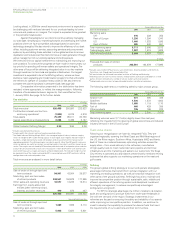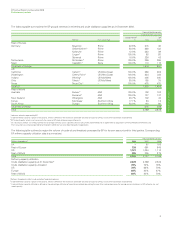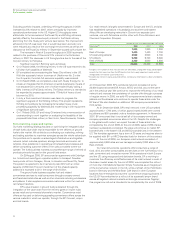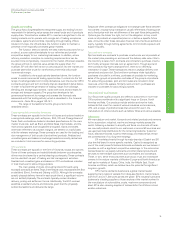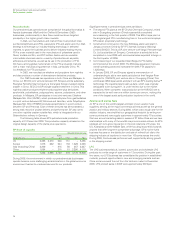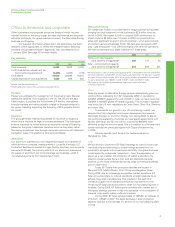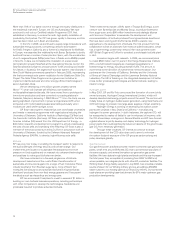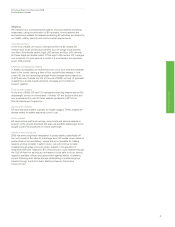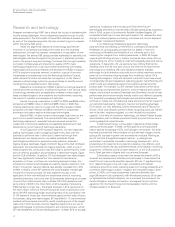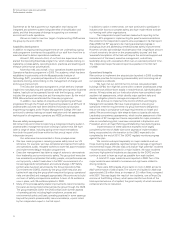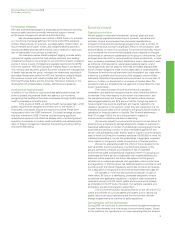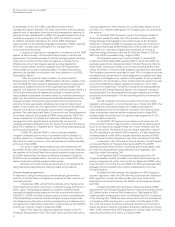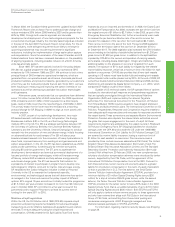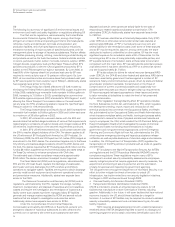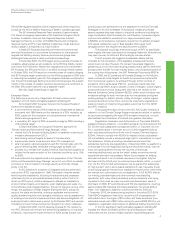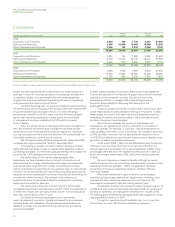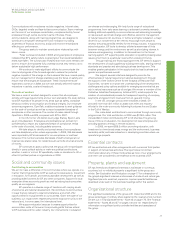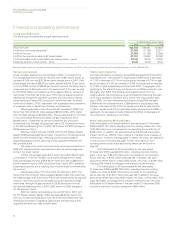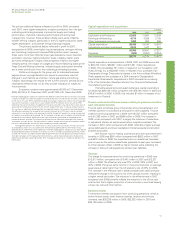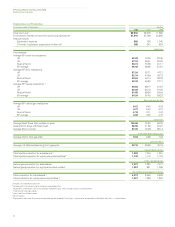BP 2008 Annual Report Download - page 43
Download and view the complete annual report
Please find page 43 of the 2008 BP annual report below. You can navigate through the pages in the report by either clicking on the pages listed below, or by using the keyword search tool below to find specific information within the annual report.
BP Annual Report and Accounts 2008
Performance review
Experience so far has supported our expectation that having one
integrated and coherent system brings benefits of simplification and
clarity, and that the process of change is supporting our renewed
commitment to safe operations.
We are on track to meet our target of implementing OMS across
the group by the end of 2010.
Capability development
In addition to ongoing training programmes we are undertaking a group
wide programme to enhance the capability of our staff from front line to
executive level to deliver operational excellence.
Almost 1,000, around a third, of our front-line supervisors have
started the Operating Essentials programme, which includes training on
leadership, process safety, operating culture, practices and coaching and
effective performance conversations.
More than 190, around half, of our operations leaders started the
Operations Academy programme in 2008. The academy, which has been
established in partnership with the Massachusetts Institute of
Technology (MIT), provides participants with a total of six weeks of
operations training, concentrating on the management of change and
continuous improvement.
The Executive Operations programme, which seeks to increase
insight into manufacturing and operation activities among senior business
leaders, has built on its successful launch with the first group, which
included the group chief executive and his executive team. By the end of
2008, 99 executives had attended the three-day programme.
In addition, new cadres of projects and engineering staff have
progressed through the Project and Engineering Academy at MIT and 13
process safety courses have been delivered for project and project
engineering managers at the Project Management College. We have
continued to develop training on hazard evaluation and risk assessment
techniques for all engineers, operators and HSSE professionals.
Process safety management
We remain fully committed to becoming a recognized industry leader in
process safety management and are working to achieve this. We have
taken a range of steps, including acting on the recommendations
from both the panel and those within the first annual report of the
independent expert.
Our actions can be summarized in three principal areas:
• We have made progress in reducing process safety risk at our US
refineries. For example, we have completed and learned from safety
and operations audits, relocated workers to lower-risk accommodation
and implemented fatigue reduction programmes.
• Executive management has taken a range of actions to demonstrate
their leadership and commitment to safety. The group chief executive
has consistently emphasized that safety, people, and performance are
our top priority, a belief made clear in his 2007 announcement of a
forward agenda for simplification and cultural change in BP. Safety
performance has been scrutinized by the Group Operations Risk
Committee (the GORC), chaired by the group chief executive and
tasked with assuring the group chief executive that group operational
risks are identified and managed appropriately. We continued to build
our team of safety and operations auditors. A team of 45 auditors is
now in place, with 36 audits completed in 2008.
• Many of the process-safety related improvements recommended by
the panel are being implemented across the group through the OMS.
The group essentials within the OMS (which cover diverse aspects
of operating activity including legal compliance, process and
environmental safety and basic operating practices) in some cases go
beyond the panel’s process safety recommendations, a point noted
by the independent expert in his first report.
In addition to action in these areas, we have continued to participate in
industry-wide forums on process safety and have made efforts to share
our learning with other organizations.
The independent expert has been tasked with reporting to the
board on BP’s progress in implementing the panel’s recommendations.
We welcome the independent expert’s view expressed in his first report
(May 2008) that BP ‘appears to be making substantial progress in
changing culture and addressing needed process safety improvements’.
However, we also acknowledge his observation that ‘a significant amount
of work remains to be done on the process safety journey’ and that
’successful completion of the task will require the continued support and
involvement of the board, executive management, and refinery
leadership along with a sustained effort over an extended period of time’.
The independent expert’s second report is expected in the first half
of 2009.
Operational integrity
We continue to implement the six-point plan launched in 2006 to address
immediate priorities for improving process safety and minimizing risk at
our operations worldwide.
We have met our commitment to remove occupied portable
buildings (OPBs) from high-risk zones within onshore process plant areas
and to remove all blow-down stacks in heavier-than-air, light hydrocarbon
service. All major sites and our fuels value chains have completed major
accident risk assessments, which identify major accident risks and
develop mitigation plans to manage and respond to them.
We continue to implement the Control of Work and Integrity
Management standards. We have made progress in ensuring our
operations meet the requirements of a group framework designed to
ensure we stay in compliance with legal requirements on health and
safety. We are continuing to take steps to close out past audit actions.
Leadership competency assessments, which involve assessment of the
experience of BP management teams responsible for major production
sites or manufacturing plant, have been completed in Exploration and
Production and in all major Refining and Marketing manufacturing sites.
Implementation of these actions is expected to be largely
complete by the end of 2009, with some aspects of implementation
being incorporated into the transition to the OMS, expected to be
completed by the end of 2010. The GORC regularly monitors progress
against the plan.
We monitor and report separately on major incidents such as
those covering fatal accidents, significant property damage or significant
environmental impact. We also track and analyze ‘high potential’ incidents
– those that could have resulted in a major incident. All major incidents
and many high-potential incidents are discussed by the GORC and we
continue to seek to learn as much as possible from each incident.
A total of 21 major incidents were reported in 2008. Two of the
major incidents were related to hurricanes and eight were related to
driving incidents.
There were 335 oil spills of one barrel or more in 2008, similar to
2007 performance of 340 oil spills. The volume of oil spilled in 2008 was
approximately 3.5 million litres, an increase of 2.5 million litres, compared
with 2007. This was largely the result of two incidents, one at Texas City
and one at the Whiting refinery, which accounted for two-thirds of the
total reported volume of oil spilled, the great majority of which remained
contained and the oil recovered.
42


